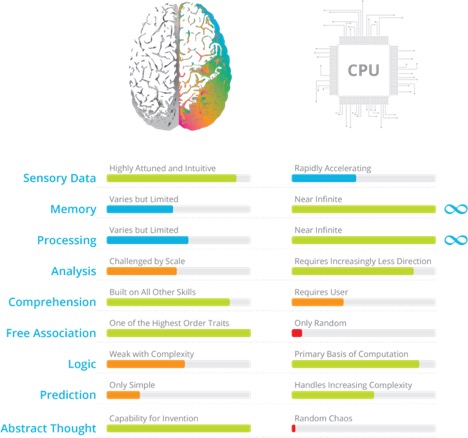The truth is, collectively, we don’t completely understand artificial intelligence (AI). As consumers, we use AI every day without realising it. For example, using Siri and Alexa is a form of AI. However, what about going beyond AI and embracing a future with Extended Intelligence (EI)?
To understand EI, we must first understand AI. AI works by bringing together large amounts of data mixed in with fast iterative processing and intelligent algorithms. This uniquely clever combination allows the software to learn from patterns or specific features in data automatically. AI can understand the meaning of human language, learn from experiences and make predictions based on the data it has.
Extended intelligence is the use of AI to enhance human intelligence. EI combines the different strengths and weaknesses of the two intelligence systems. Human intelligence is used to drive the computational intensity of AI. Although human intelligence excels at processing sensory data and understanding it along with abstract thought and free association, AI excels at remembering, processing analysis and prediction. Which why, when combined, they make a powerhouse.
It is evident that both human intelligence and AI are very different from one another. However, they have the ability to balance out each other’s weaknesses and complement each other’s strengths. As we know, the human mind has difficulties with scale, but computers can quickly and continuously keep performing an abundant amount of operations per second. Due to this reason, the marriage of the two technologies together creates endless possibilities creating strong potential for future technology.
In order to seamlessly blend the abilities of the human mind and intelligent machine cognition together, there has to be a possible workflow between the two of them to work in synergy with one another. All intelligent systems require inputs, and it is here where both human observation and sensory data should be collected and stored for use by AI intelligence.
The inputs from human intelligence will form the basis for processing and analysis for computers. Once this is done, on the receiving end, the output of this analysis which was initially fed by human input, will then need to be interpreted and understood by humans for classification and verification. Once this is done, the data can then be used to train AI algorithms to create a workflow system which will evidently be EI.
The primary role of EI systems is to understand the group and set of information and data and use it to inform and interpret the analysis in a new way. Invention and intuition together aid the combination of data to be interpreted in different ways. They are the driving forces behind teasing out a new way of working and a new way of understanding for an advanced tomorrow.
In order to use these capabilities, devices also need to be challenged and improved. The iPad is an excellent example of this. If we compare the current iPad to first-generation iPads, one of the most significant noticeable differences is the size. Consumer demands push innovation and spark new ideas that help smart tech reach new heights. The capabilities of our current smart tech are far beyond anything we ever imagined. Re-inventing antiquated technology to fit into the 21st century is the key to the future.

Image Source: Medium
Ultimately human intelligence is essential for future progress. Developing new questions and challenges not just for AI but for all technologies is an attempt to try and get the most out of them. It is essential to do so to be able to adequately use them to their full potential, which is vital. Because the human mind created advanced technologies such as AI, the tech itself cannot go beyond human intelligence. AI has no other ability other than computing large amounts of random operations and to learn from its very own input.
The truth is without human intelligence; there would be no AI. However, the combination of the two together as we have explored here shows excellent promise for the future of tech. As we slowly adopt AI into our everyday lives, extending the capabilities of current technologies will, in turn, will not only bring upon new concepts like EI but it will also create an economic knock-on effect. It will positively advance different sectors, such as Health and Manufacturing, which, with a growing population, is great.

